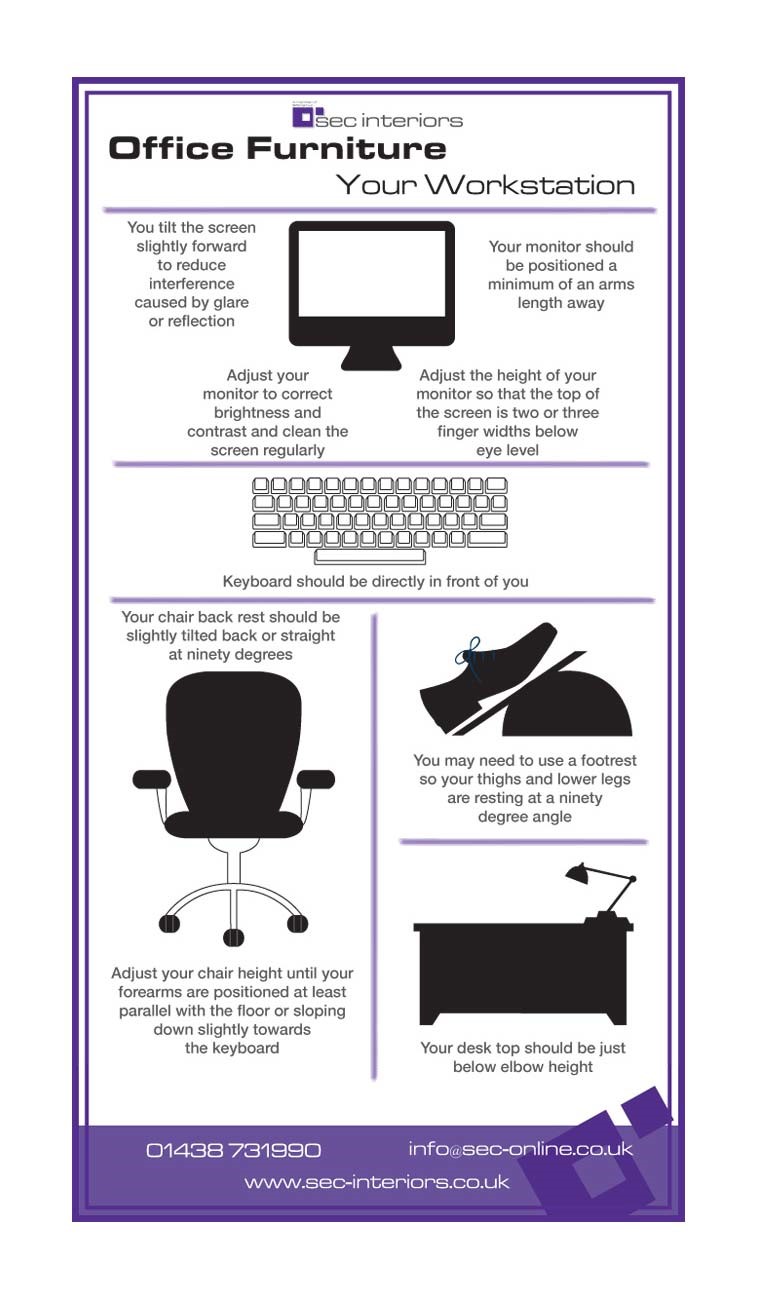Unless you work in a spacious open plan office, you’re going to spend a good proportion of your time sitting at your workstation, so it’s important that you have it set up properly. If your workspace isn’t ergonomically designed you run the risk of injuring yourself, maybe even permanently. It may sound a little farfetched, suffering an injury while sitting at your desk, but the risk is real and all too common.
Fortunately, SEC-Online, experts in warehouse storage solutions and office fit outs have created an infographic that introduces a few key tips and tricks to optimising your workspace.
Here is the advice in more detail:
The Monitor
Eye disease is a growing problem across the world, it is estimated that 1.3 billion people live with some form of visual impairment and around 80% of all vision impairment is considered avoidable– which is why it’s vitally important that your monitor use doesn’t increase your own risk.
Computer Vision Syndrome is a growing threat to the modern-day workforce with headaches, dry eyes and neck pain being common problems. Further down the line, it can exacerbate problems like age-related macular degeneration which eventually means losing your vision all together.
The best way to avoid this fate is to take frequent breaks . You can also make some simple changes to your monitor setup. Firstly, make sure your monitor is at arm’s length and only a few finger’s width beneath your eye-level so it sits at a comfortable height and distance. Then, be sure to adjust brightness and contrast settings so your eyes won’t have to work so hard to read the text. And by tilting the screen forward, you can minimise reflection and glare, as well to protect your vision. Another danger this remedies is the risk of neck and shoulder pain as you do not need to strain your neck to turn and look at the screen.
The Chair
Office chairs can be a mixed experience. Sometimes they are the perfect fit and are wonderfully comfortable, other times they can lead to severe and debilitating back pain when the support is inadequate.
Lower back pain is possibly the most common work-related injury to occur besides wrist injuries sustained from keyboards. In addition to back pain, you can suffer degradation of your hip flexors which can lead to additional lower back aches.
Essentially, a poor chair can injure your back in all manner of ways, so to keep your spine in good working order it’s well worth inspecting your chair first.
First thing to check, does the length of your chair cover the entirety of your back? If it doesn’t, use a lumbar pillow to ensure you have adequate support. The chair’s back should also be either straight at a 90-degree angle or slightly tilted back.
Your chair can also help with wrist pain by providing forearm support to keep your wrists straight. To prevent tight hips at your desk, use a footrest to ensure your feet and legs are at an angle to take some pressure off your back.
The Keyboard
Typing is part of most people’s day-to-day, whether you are browsing on a desktop at home, writing a blog post or, for a lot of people, working in an office. Nearly everyone will use a computer at some point in their day and/or work life, but this leaves you prone to potentially severe wrist and hand injuries.
Due to the way your tendons are positioned, Repetitive Strain Injuries (RSI) are on the rise and with computers so common in both work and our home-life, making sure we’re protecting ourselves is essential.
Wrist injuries as a whole are actually impacted by a number of office elements but the keyboard is a prime offender. Your keyboard should be directly in front of you to avoid unnecessary tendon strain, while your wrists should be positioned horizontally in the air. It can also be useful to get a wrist-rest for your mouse and keyboard. The other thing you can use to help your wrists is to adjust your chair – set it at the right height to alleviate any wrist strain ensuring your desk-top is just below elbow height.
Injuries at work are serious business and just as you’d be sure to wear a hardhat in a warehouse, making sure you protect yourself from injuries at your desk is as important.
Image Credits: Markus Spiske





Like this article? Share with your friends!